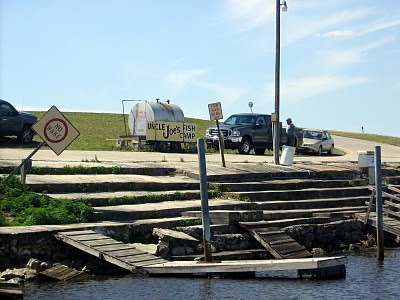Moore Haven, FL
26 49.44 N 081 05.80 W
My friend Chuck likes it when I paint pictures with words. I can only do so when the vision I'm seeing inspires the words. See what you think of today's vision.
Imagine sitting in a pool of water far enough from land that the shore is not visible in most directions. The wind is calm. There are no waves. The surface is very flat. Above is a pristine pale blue sky. Not even so much as a contrail from a passing jet blemishes this pale blue sky. Not a cloud is visible in any direction except that there is a dotted line of puffy little clouds exactly over the shore line of this lake. No clouds over land, none over the water, just small clouds around the perimeter. Such is Lake Okechobee this morning.
This lake is about 15 miles across but only 10 feet deep. It sits in the middle of the Florida peninsula. It is the headwater of the so called river of grass that flows south from here through the Everglades.
It is around 9 in the morning. Libby and I are finding our way across the lake lazily. We're in no hurry today. The weather is very pleasant. Low humidity and the temperature around 70F (21C).
Suddenly, we look to the south and we see a huge mushroom cloud. Indeed, there are a half dozen mushroom clouds soaring up into the sky. A nuclear holocaust? Hardly. It is the sugar cane fields burning off their waste. They light big fires almost every day. Looking still closer, I can see that one of the clouds is four dimensional. What does that mean? I'll explain.
As a plume of smoke rises it is blown at an angle by the prevailing wind. The angle of the column is proportional to the wind speed while the angle of the column shows the wind direction. Direction makes two dimensions. This cloud didn't have a mushroom head. Instead, at an altitude of about 1000 feet the top was flattened and cut off. Downwind one could see a wisp of the smoke trailing away at that same 1000 foot ceiling. Obviously this was the result of vertical wind shear. At 1000 feet and higher there was a wind blowing that did not blow at the surface. (One more dimension.) Finally, I notices that this cloud was grey while the other clouds were white. Further, the white clouds had mushroom tops much higher than 1000 feet without being cut off by the vertical wind shear. How could that be? It must be then that the flattened cloud was older, perhaps it burned overnight. The vertical wind shear was present at night but not at 9 AM. There is Einstein's fourth dimension -- time. That's why I call it my four dimensional cloud.
After a couple of hours we approach Clewiston on the west side of the lake. Here the 20 foot high levy is very prominent. There is a lock cut through the levy at this point that allows boats to get in to a marina *behind* the levy. Remarkable.
Why such a big levy? To prevent flooding of course. Duh. But does the lake really increase from 10 feet deep to 30 feet deep? Well, the level of this lake varies a lot. That's true. However, I suspect that another factor is sloshing. Okechobee is 7500 times wider than it is deep. Imagine a pizza pan that is 25 feet in diameter, has a 1/4 inch lip around the edge and is covered in 1/16 inch of water (7.5 meters in diameter, which has a 3 mm lip around the edge and is covered with 1 mm of water.) What would it take to make that water slosh over the edge. How about if we set up a fan to blow on the surface. I bet that would do the trick. We know that Lake Champlain sloshes and Chesapeake Bay sloshes.
I believe that because of the 7500:1 diameter to depth ratio of Lake Okechobee that sloshing is even more pronounced, hence the need for big levees. I haven't checked my theory on the Internet yet, and it will be a few days until I'm online once again. That gives you the chance to do your own Internet research to confirm or refute my theory before I get to do it myself.
After reaching Clewiston, the waterway takes us up a remarkable canal. To our left was the levy. To our right was 5-10 miles of marshes and wetland between us and the open water of the lake. We saw a wonderful quantity and assortment of birds. One can only imagine the wealth of wildlife living out there. We saw only one alligator. It's still pretty cold for them. We saw no mosquitoes or bugs thank god. The cold did them in too. In the heat of summer though I bet the place really crawls with alligators and bugs galore.
I'm really glad we took this trip. Even if we've seen places more exotic than Lake Okechobee, every new place we explore for the first time is a mini adventure and brings us new sights, sounds, smells, and experiences.


















